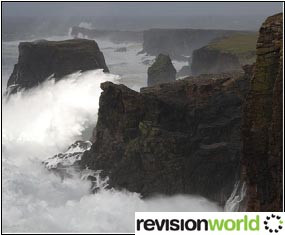Coastal Erosion
Processes of coastal erosion can operate in isolation but often work in combination along a coast.
Subaerial processes cause a great deal of cliff recession along some coasts, particularly in areas of soft, sedimentary rocks.
Cliffs can become saturated with water by throughflow. Cliffs become weakened by weathering processes, particularly freeze-thaw.
As a result mass movement processes, whether slow soil creep or more dramatic slumps and landslides, can cause rapid retreat of the coastline in combination with marine processes of erosion and transport.

Wave pounding
- Results from the weight of water in individual waves striking the coast.
- Typical winter storms may generate waves with an average pressure of 10 tonnes per square metre.
- This can rise to 30 tonnes per square metre in extreme conditions.
Hydraulic pressure
- Results from air trapped in cracks by high-energy waves.
- As waves hit the cliffs, air is compressed and then suddenly released.
- This process weakens cliffs and enlarges cracks.
On most coasts, storm waves are able to pick up large quantities of beach material and hurl it at the cliffs. In this way, the process of abrasion (corrasion) becomes a powerful force which erodes mainly the lower part of the cliffs.
Where the geology is suitable, corrosion (solution) can be an effective erosive force. In areas of limestone or chalk rocks, the sea is often a milky colour where the rock material has become dissolved in the seawater. The salt in seawater is also capable of corroding some rock types.
Rates of erosion along the coast are determined by:
- supply of beach material
- beach morphology
- rock resistance, dip and structure of the rock layers
- type of waves
- depth of sea
- direction that coastline faces
